#Pliosauroidea
Text
Fish of the Day
Today's fish of the day is the Freshwater Plesiosaur!
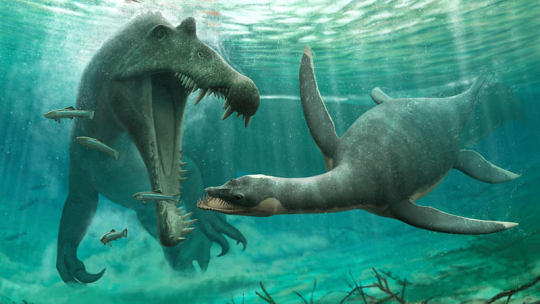
The freshwater plesiosaur was requested by Jasper, thank you Jasper! Plesiosaurus as a marine reptile, well known for their prowess as apex predators, but freshwater plesiosaurs are a relatively new idea. Based on the finding of a couple of fossils in what is now Morocco's Sahra desert river system, specifically an area called the Kem Kem beds. These fossils are scattered, showing us that this is not just the bones of one animal but a group of freshwater plesiosaurs that lived in the area, at least a dozen of them. The finding of many teeth in particular shows that these animals didn't just swim in from the ocean temporarily, but lived in the area long enough to shed teeth. This has led to some theories that the popular cryptid, The Loch Ness Monster, may be a freshwater plesiosaur, although no fossils have been yet found in that area. Although this does not confirm their existence it raises a strong argument for them. However, with limited knowledge about them for the time being, let's go over plesiosaurs in general!
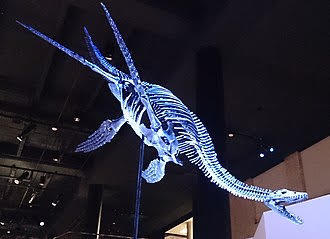
Found and named in the early 1800's the plesiosaur, from order Plesiosauria, is thought to have first appeared in the late Triassic Rhaetian stage, about 203 million years ago. These animals went extinct about 66 million years ago, to the Cretaceous-Paleocene extinction event. How they swam is still up for debate, many favor the theory that they had wide range with each of their fins, and had identical strokes, but other theories are that they may have used only the fore or hind fins for locomotion, or perhaps used them in reciprocal movement. Similar debate exists for how these animal may have dived, although we know they dived for food, as signs of decompression sickness have been found. As apex predators they ate through anything they could get close to, small fish, larger fish, sharks, cetaceans, crustaceans, one another. It is found that although they were certainly near the top of the food chain, some of them were still occasionally prey for large sharks, but mostly they fell to one another, larger plesiosauria hunting smaller. It is thought they evolved to fill the niche left open by the extinction of Ichthyosaurs, which died out in the late Cretaceous, and allowed for diversification to take place in Plesiosauria. Plesiosauria during this era evolved two distinct morphological types: the pliosauromorph build, the Pliosauroidea family, and the plesiosauromorph build, the Plesiosauroidea family.
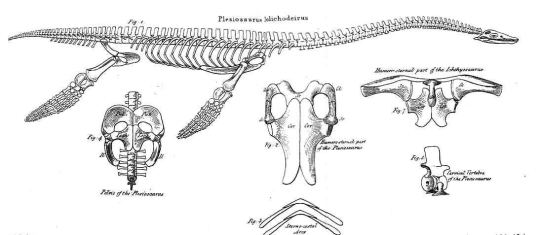
Pliosauroidea is defined by their large heads and short necks, often compared to the build that crocodiles have. They are also known for having larger hind flippers than other plesiosaurs and can be found mostly across South America, and along the equator, although some fossils have been found as far north as Norway. The largest genus found so far, the Liopleurodon, is as large as 6 feet 5 inches, or just a little under 2 meters.

Plesiosauroidea was defined by the long skinny neck, which was used to hunt in small holes, and could move fast to snap up small marine animals nearby them. Although Plesiosauroidae is often depicted as a fast moving predator, it is found that they were likely slow swimmers, pushing their way through the water similar to the swimming methods of turtles, staying close to the surface and using their four limbs for mobility, making it easy to snap at nearby animals. Despite the common displays of them in swan-like positions, with the head raising out of the water, this is unrealistic, as they could not raise their heads up to a degree like that, and the weight of the muscles would prevent them from surfacing. The size difference between differing species was huge, as some could be only as large as 3 meters to 20 meters in length. It is currently thought that the freshwater finds belong to Plesiosauridea.
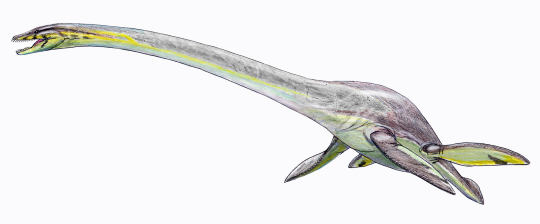
Everyone have a good day!
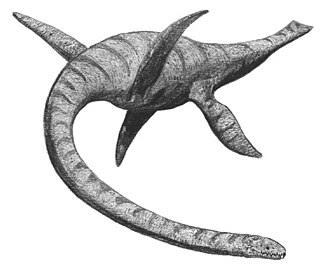
#fish#fishblr#fishes#fishposting#aquatic biology#aquatic#marine biology#ichthyology#marine animals#marine life#freshwater#freshwater fish#animal#animals#animal facts#fish of the day#information#education#nature#river#paleo#paleontology#plesiosaur#plesiosaurus#freshwater plesiosaur#Plesiosauria#Pliosauroidea#Plesiosauroidea
28 notes
·
View notes
Text

Part 3 of the series “Life Finds A Way.” Parts 1 and 2 can be found here. Presented below are letters I to L.

1. Ichtyosaurus (Top right) - Genus*- Marine reptile. Time- Early Triassic to Late Cretaceous (250-90 mya). Length- On an average, Ichtyosaurus were 2–4 m (6.6–13.1 ft) while some species grew up to 21m (69ft). Weight - an 8ft long Ichtyosaur is estimated to have weighed around163–168 kg (359–370 lb), while a 4 m (13 ft) Ichtyosaurus weighed about 930–950 kg (2,050–2,090 lb.
2. Ichthyostega (Top left) - Genus- Tetrapodomorphs. Time- Late Devonian (365-360 mya). Length- 1.5 m (4.9 ft). Weight - approx 22.5kgs (50lbs).
3. Jiangxisaurus (Bottom left)- Genus- Oviraptoroid theropod. Time- Late Cretaceous (72-66mya). Description- The species is known from a single holotype** specimen which appears to be a sub adult. The specimen consists of an incomplete skull, a lower jaw, eight cervical vertebrae, three dorsal vertebrae, nine caudal vertebrae, a nearly complete pectoral girdle, two chevrons, the left forelimb, both sternal plates, four sternal ribs, nine dorsal ribs, and a partially preserved pelvic girdle. The skull is 150mm long. Hence the exact size and weight of the species is not known.
4. Jaekelopterus (Bottom left)- Genus- Eurypterid. Time- Early Devonian (410.8- 402.5mya). Length- 2.3–2.6 metres (7.5–8.5 ft). Weight- not known.

1. Kaprosuchus (Top left)- Genus- mahajangasuchid crocodyliform. Time- Late Cretaceous (95mya). Length- 6 metres (19.7 ft). Weight- around 907kg (2,000lbs).
2. Kronosaurus (Top right)- Genus- short-necked pliosaur.Time- Early Cretaceous (120-100 mya). Length- 9 to 10.9 meters (30 to 36 ft) Weight- 10.6 to 12.1 metric tons (11.7 to 13.3 short tons).
3. Longisquama (Bottom left)- Genus- reptile. Time- Middle or Late Triassic (235mya). Description- Since the species is known from a holotype specimen, the size estimates are not available.
4. Liopleurodon (Bottom right)- Genus- Pliosauroidea. Time- Middle-Late Jurassic (166-155mya). Length- 5 to 7 m (16 to 23 ft). Weight- 1 and 1.7 t (2,200 and 3,700 lb).
* Genus- A genus (plural genera) is a taxonomic rank used in the biological classification of living and fossil organisms, as well as viruses,in biology. In the hierarchy of biological classification, genus comes above species and below family.
**Holotype- A holotype is a single physical example (or illustration) of an organism, known to have been used when the species (or lower-ranked taxon) was formally described.
PS: Feel free to DM me if you want to know more.
6 notes
·
View notes
Photo










09.06.20
We watched Ice Age 2 The Meltdown (2006).
IMDb link:
https://www.imdb.com/title/tt0438097/
Ice Age 2 The Meltdown was released in 2006, four years after the first Ice Age adventure. It was produced by Blue Sky Studios and distributed by 20th Century Fox. It is directed by Carlos Saldanha.
In Ice Age 2, Manny, Sid, and Diego are currently living in a large valley surrounded by an enormously high ice wall on all sides.
The animals see the beginning of the meltdown as fun, turning their landscape into a giant water park. What they didn't realise (as Carlos Saldanha says) is that it is in fact the start of global warming and the melting of the ice, which would flood the valley and change their environment.
However, the trio discovers that the ice wall is actually a dam that is barely holding a massive body of water that could flood the valley to nearly a mile underwater.
Wikipedia link: https://en.wikipedia.org/wiki/Ice_Age:_The_Meltdown
The film makes reference to global warming which would have a huge impact on not only the climate and temperature in the animated world, but also our own.
In Ice Age 2 The Meltdown, the characters designs were updated and have evolved from the first film. The character designs remain unchanged throughout the franchise. Throughout the film, the herd are shown to live alongside various background animal characters, some of who have minor speaking roles in the film.
Realflow software was used to simulate the water effects in the film. This still looks very effective in 2020.
In the film all three characters face emotional fears as well as physical ones. Manny, must overcome his fear of becoming the last mammoth. This was overcome when he met Ellie.
Sid was shown to have a great fear of being unloved and unneeded. At the end of the film Diego tells Sid he is the sticky glue that holds the herd together.
The film reveals that Diego's fear is water. He finally brakes this fear when he rescues Sid from drowning.
Manny's mate Ellie discovers the truth of her past (Ellie believes she is a large possum) after her family were lost in a blizzard and that she was brought up by a family of possums. The two possums by her side are Crash (Voiced by Sean William Scott) and Eddie (Voiced by Josh Peck) .
Other subplots into the film include Cretaceous, which is a Cymbospondylus and Maelstrom, which is a Pliosauroidea. These two sea reptiles from the Mesozoic era thawed out of an ice berg in the early part of the film.
Another humorous element to the film are the vultures, who see the oncoming flood as an opportunity for an easy meal. One of the vultures tells the animals about a hollow tree trunk that can be used as a boat. When the animals are in this it is very reminiscence of the Noah's Ark story.
In Ice Age and Ice Age 2 The Meltdown, there are clues to the next Ice Age installment.
In Ice Age, Sid explains at the end that he is tired of the Ice Age and that he would like global warming. This leads to The Meltdown.
In Ice Age 2, a minor character asks Manny about what happened to the dinosaurs. This leads to Dawn of the Dinosaurs.
The minor character who asks this question is the Diatryma Mum (Voiced by Debi Derryberry).
The soundtrack is composed by John Powell.
Ice Age 2 also features the song "Food Glorious Food" which is sung by the Lone Gunslinger Vultures after Sid wonders what the vultures are thinking.
The featured song that plays during the credits is ‘Real Love’ by Lee Ryan. Lee Ryan also voices an Elk character in the UK theatrical version of the film.
Ice Age 2 The Meltdown is my second favourite film in the franchise after the original Ice Age.
9 notes
·
View notes
Text
Megalneusaurus rex

Art by: Dmitry Bogdanov, Public Domain
Name: Megalneusaurus rex
Name Meaning: Great swimming lizard king
First Described: 1895
Described By: Knight
Classification: Chordata, Tetrapoda, Reptilia, Sauropterygia, Plesiosauria, Pliosauroidea
Megalneusaurus swam the Sundance Sea during the Late Jurassic. We have its vertebrae, ribs, and portions of the front flipper. It is hypothesized that Megalneusaurus could have grown to a size similar to that of Liopleurodon, see my previous post on that. Megalneusaurus probably ate other marine reptiles or whatever it could take down.
Sources:
https://en.wikipedia.org/wiki/Megalneusaurus
#Megalneusaurus#palaeoblr#paleontology#palaeontology#prehistoric#Mesozoic#ancient marine reptiles#Not a dinosaur#sauropterygia
101 notes
·
View notes
Link

Instead of laying eggs like other reptiles, a mother Polycotylus gave birth to a single, large offspring. Here, an artist imagines what that looked like.Stephanie Abramowicz/NHMLA
Unlike some better-known long-necked plesiosaurs like Plesiosaurus and Elasmosaurus, Polycotylus had a short neck. This led to it being classified as a pliosaur, a marine reptile within the superfamily Pliosauroidea, closely related to true plesiosaurs (which belong to the superfamily Plesiosauroidea). Polycotylus and other polycotylids superficially resemble pliosaurs like Liopleurodon and Peloneustes because they have short necks, large heads, and other proportions that differ from true plesiosaurs. As phylogenetic analyses became common in the last few decades, the classification of Polycotylus and other plesiosaurs have been revised. In 1997, it and other polycotylids were reassigned as close relatives of long-necked elasmosaurids. In a 2001 study, Polycotylus was classified as a derived cryptocleidoid plesiosaur closely related to Jurassic plesiosaurs like Cryptocleidus.
Viviparity, or live birth, may have been the most common form of reproduction in plesiosaurs, as they would have had difficulty laying eggs on land. Their bodies are not adapted to movement on land, and paleontologists have long hypothesized that they must have given birth in water.
22 notes
·
View notes
Text
Liopleurodon ferox, L. pachydeirus

By Jack Wood on @thewoodparable
PLEASE SUPPORT US ON PATREON. EACH and EVERY DONATION helps to keep this blog running! Any amount, even ONE DOLLAR is APPRECIATED! IF YOU ENJOY THIS CONTENT, please CONSIDER DONATING!
Name: Liopleurodon ferox, L. pachydeirus
Name Meaning: Smooth-sided Teeth
First Described: 1873
Described By: Sauvage
Classification: Cellular Life, Archaea, Proteoarchaeota, Eukaryota, Unikonta, Opisthokonta, Holozoa, Filozoa, Metazoa, Eumetazoa, Planulozoa, Bilatera, Nephrozoa, Deuterostomia, Chordata, Craniata, Vertebrata, Gnathostomata, Eugnathostomata, Teleostomi, Euteleostomi, Sarcopterygii, Rhipidistia, Tetrapodomorpha, Eotetrapodiformes, Elpistostegalia, Stegocephalia, Tetrapoda, Reptiliomorpha, Anthracosauria, Batrachosauria, Cotylosauria, Amniota, Sauropsida, Eureptilia, Romeriida, Diapsida, Neodiapsida, Sauria, Archosauromorpha, Pantestudines, Eosauropterygia, Pistosauroidea, Pistosauria, Plesiosauria, Pliosauroidea, Pliosauridae
Happy April Fool’s! As per tradition, I am writing an article about a non-dinosaur - specifically, the marine reptile Liopleurodon. Made famous by the landmark documentary series Walking with Dinosaurs, Liopleurodon was not really much like as shown in that series - though an important marine predator, it wasn’t... huge. In fact, it was really just around the same length, at maximum, as the modern orca, so there is that misconception shattered.

Never forget. By Slate Weasel, in the Public Domain
The reason for this misconception is primarily because the skeleton of pliosaurs like Liopleurodon are not really well known, and in fact it was difficult to estimate the size of Liopleurodon in the first place, though of course, it was a known exaggeration to portray it so large. Since the program was made, research of another pliosaur, Kronosaurus, has shown that the heads of these animals made up about one fifth of their total body length - which shows how weird their heads were, for one, but for two it allowed for the estimation of Liopleurodon’s body size based on its skull. It’s skull was, overall, about 1.51 meters in length, making its body around 6.39 meters long.

By Nobu Tamura, CC BY 2.5
Liopleurodon is known from near Boulogne-sur-Mer and Caen in France, but other fossils are known from England, Russia, and Germany. It lived about 166 to 160 ish million years ago, in the Callovian to Oxfordian ages of the Middle to Late Jurassic, though of course it may have lived longer than that. A large predatory reptile of the Jurassic seas of Europe, it would have been a powerful swimmer, using its four flippers to accelerate rapidly, ambushing prey in the seas. It may have even been a good smeller, able to locate prey easily, and then rush after it to attack it.
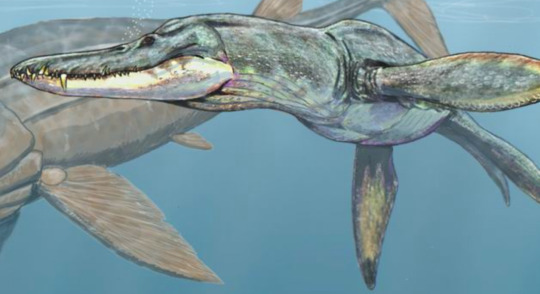
By Dmitry Bogdanov, CC BY 2.5 - note that the fish in the background is inaccurate
Liopleurodon was a pliosaur, a group of marine reptiles a part of the bigger group of Plesiosaurs. Though Liopleurodon had a short neck, it’s a common misconception that the difference between Pliosaurs and other Plesiosaurs is that Pliosaurs had short necks - plenty of Pliosaurs didn’t have short necks (though most did, and long heads to boot), and there are Plesiosaurs to the exclusion of Pliosaurs with short necks and long heads same as Pliosaurs. Sill, Liopleurodon was fairly typical for its group, and a common figure in its environment.
Sources:
https://en.wikipedia.org/wiki/Liopleurodon
https://en.wikipedia.org/wiki/Plesiosauroidea
https://en.wikipedia.org/wiki/Plesiosauria
https://en.wikipedia.org/wiki/Pliosauroidea
#liopleurodon#liopleurodon ferox#liopleurodon pachydeirus#pliosaur#palaeoblr#prehistoric life#plesiosaur#marine reptile#paleontology#prehistory#biology#science#nature#factfile
123 notes
·
View notes
Photo

Name: Liopleurodon (Smooth sided teeth).
Phonetic: Lie-oh-ploor-oh-don.
Named By: Henri-Émile Sauvage - 1873.
Classification: Chordata, Reptilia, Sauropterygia, Plesiosauria, Pliosauroidea, Pliosauridae.
Type: Carnivore.
Size: Most complete specimen 6.39 meters long, isolated remains suggest that larger individuals reached 7-7.5 meters long.
Known locations: England, France and Germany. Possibly further afield with possible fossils being located in Argentina and Mexico.
Time period: Callovian through to the Tithonian of the Jurassic. Possibly into the early Cretaceous.
Fossil representation: Many specimens, with material from several skulls. Only L.ferox represents an almost complete skeleton.
0 notes
Text
#liopleurodon is a genus of large, #carnivorous marine #reptile belonging to the #pliosauroidea, a clade of the short-necked #plesiosaurs. Two species of Liopleurodon,lived during the #callovian stage of the Middle #jurassic 160 million to 150 million years ago mya #animatronics #ZigongInnova #prehistoric #animatronicsculpture #simulatedanimal #artificial #animatronicdinosaurs #robotic #mechatronic #zigong #Innova #oceanmonsters
0 notes
Text
Week Twelve: Liopleurodon
Disclaimer: All picture, other than pictures of bones, are computer rendering of what scientist believe this creature looked
The Liopleurodon a Beast of the Prehistoric Seas
This beast lived approximately 160 million to 150 million years ago during the Middle Jurassic Period. Its fossil found in parts of Europe, such as England, France, and some in Russia, tell this creature’s size could be as big as 33 feet to 16 ft in length. The body mass is estimated to be about 2,200 and 3,700 lb.

The Liopleurodon had 4 paddle-like limbs suggesting it could’ve been a powerful swimmer. It could swim up to 25 mph. It is a predator with fossil evidence of its teeth being about 18 inches in length!
Taxonomy
Scientific classification
Kingdom:Animalia
Phylum:Chordata
Class:Reptilia
Order: Plesiosauria
Suborder: Pliosauroidea
Family: Pliosauridae
Genus: Liopleurodon

This about all the information there is about these wild Jurassic creatures.
Bye! and see you next week!
0 notes
Text
Bishanopliosaurus youngi, B. zigongensis
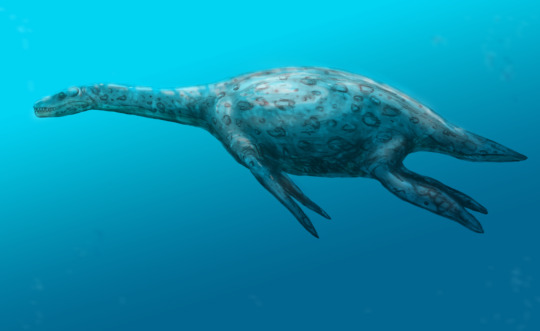
Art by: FunkMonk (Michael B. H.) - Own work, CC BY-SA 3.0
Name: Bishanopliosaurus youngi, B. zigongensis
Name Meaning: Bishan Mountain Pliosaurus
First Described: 1980
Described By: Dong
Classification: Chordata, Tetrapoda, Reptilia, Sauropterygia, Plesiosauria, Pliosauroidea
Bishanopliosaurus lived during the Early Jurassic and was discovered in China’s Dashanpu Formation. Just like the previous post of Yuzhoupliosaurus, Bishanopliosaurus may have also lived in a fresh marine ecosystem.
Sources:
https://en.wikipedia.org/wiki/Bishanopliosaurus
#Bishanopliosaurus#palaeoblr#paleontology#palaeontology#prehistoric#Mesozoic#ancient marine reptiles#Not a dinosaur#sauropterygia
25 notes
·
View notes
Text
Eurycleidus arcuatus

Art by: Adam S. Smith
Name: Eurycleidus arcuatus
Name Meaning: Wide clavicle
First Described: 1922
Described By: Andrews
Classification: Chordata, Tetrapoda, Reptilia, Sauropterygia, Plesiosauria, Pliosauroidea, Rhomaleosauridae
Eurycleidus was a primitive rhomaleosaurid that existed during the Early Jurassic and was discovered in the United Kingdom. This marine reptile had big shoulders which we can infer that it was a quick swimmer. The agility of Eurycleidus probably was helpful when taking down fish or other kinds of prey in the Jurassic seas.
Sources:
https://en.wikipedia.org/wiki/Eurycleidus
#eurycleidus#palaeoblr#paleontology#palaeontology#prehistoric#mesozoic#ancient marine reptiles#not a dinosaur#sauropterygia
22 notes
·
View notes
Text
Simolestes vorax, S. indicus, S. keileni

Art by: Nobu Tamura, CC BY-SA 4.0
Name: Simolestes vorax, S. indicus, S. keileni
Name Meaning: Hearkening thief
First Described: 1909
Described By: Andrews
Classification: Chordata, Tetrapoda, Reptilia, Sauropterygia, Plesiosauria, Pliosauroidea, Pliosauridae
Simolestes was a Middle to Late Jurassic pliosaur that was discovered in England’s Oxford Clay Formation. In addition, specimens have been found in India and in France. Simolestes probably consumed squid and fish. It’s hypothesized that it may have hunted for squid at night or also swam to deeper depths to hunt squid. This is hypothesized because cephalopods of today typically come out at night to feed, but during the day they dwell in deeper waters.
Sources:
http://www.prehistoric-wildlife.com/species/s/simolestes.html
https://en.wikipedia.org/wiki/Simolestes
#Simolestes#palaeoblr#paleontology#palaeontology#prehistoric#Mesozoic#ancient marine reptiles#Not a dinosaur#sauropterygia
23 notes
·
View notes
Text
Rhomaleosaurus cramptoni, R. propinquus, R. thorntoni, R. zetlandicus

Art by: Curtis Lanaghan, https://www.deviantart.com/clanaghan/art/Rhomaleosaurus-419532119
Name: Rhomaleosaurus cramptoni, R. propinquus, R. thorntoni, R. zetlandicus
Name Meaning: Strong lizard
First Described: 1874
Described By: Seeley
Classification: Chordata, Tetrapoda, Reptilia, Sauropterygia, Plesiosauria, Pliosauroidea, Rhomaleosauridae
Rhomaleosaurus was an Early Jurassic pliosaur that was lumped into a wastebasket taxon in the past. It was originally thought to be a new species of Plesiosaurus, until Seeley saw the clear distinctions that it wasn’t. Later, it was mistakenly re-assigned to be a new genus called Thaumatosaurus. Rhomaleosaurus has so far only been found in England, particularly the Whitby Mudstone Formation. What’s also really fascinating is that its nares (nostrils) indicate that it had a keen sense of smell and could detect blood and various scents while trying to track down potential prey.
Sources:
http://www.prehistoric-wildlife.com/species/r/rhomaleosaurus.html
https://en.wikipedia.org/wiki/Rhomaleosaurus
#Rhomaleosaurus#palaeoblr#paleontology#palaeontology#prehistoric#mesozoic#ancient marine reptiles#Not a dinosaur#sauropterygia
24 notes
·
View notes
Text
Polyptychodon interruptus

Art by: Dmitry Bogdanov, CC BY 3.0
Name: Polyptychodon interruptus
Name Meaning: Shaped fin tooth
First Described: 1841
Described By: Owen
Classification: Chordata, Tetrapoda, Reptilia, Sauropterygia, Plesiosauria, Pliosauroidea, Pliosauridae
Polyptychodon is only known from one single tooth. Many paleontologists consider this pliosaurid to be a nomen dubium as a result. The tooth dates all the way back to the Late Cretaceous and was found in England. Some vertebrae has also been found, but it most likely belongs to other types of plesiosaurs.
Sources:
http://www.prehistoric-wildlife.com/species/p/polyptychodon.html
https://en.wikipedia.org/wiki/Polyptychodon
#Polyptychodon#palaeoblr#paleontology#palaeontology#prehistoric#Mesozoic#Not a dinosaur#sauropterygia
22 notes
·
View notes
Text
Thalassiodracon hawkinsi

Art by: Nobu Tamura, CC BY 2.5
Name: Thalassiodracon hawkinsi
Name Meaning: Sea dragon
First Described: 1996
Described By: Storrs & Taylor
Classification: Chordata, Tetrapoda, Reptilia, Sauropterygia, Plesiosauria, Pliosauroidea
Originally, Thalassiodracon was thought to be another species of Plesiosaurus, but later was determined to be a new genus due to further examination of its skull which showed that it had a way bigger skull than Plesiosaurus. Since the skull of Thalassiodracon is large for its body size, it’s considered to be a pliosaur and not a plesiosaur. Thalassiodracon existed during the Late Triassic through the Early Jurassic. Many individual fossil specimens have been discovered from England, and they were mostly complete as well.
Sources:
http://www.prehistoric-wildlife.com/species/t/thalassiodracon.html
https://en.wikipedia.org/wiki/Thalassiodracon
#Thalassiodracon#palaeoblr#paleontology#palaeontology#prehistoric#Mesozoic#ancient marine reptiles#Not a dinosaur#sauropterygia
16 notes
·
View notes
Text
Liopleurodon ferox, L. pachydeirus

Art by: Joschua Knüppe, https://www.deviantart.com/hyrotrioskjan/art/Liopleurodon-ferox-524697439
Name: Liopleurodon ferox, L. pachydeirus
Name Meaning: Smooth sided teeth
First Described: 1873
Described By: Sauvage
Classification: Chordata, Tetrapoda, Reptilia, Sauropterygia, Plesiosauria, Pliosauroidea, Pliosauridae, Thalassophonea
I am sure everyone is very familiar with Liopleurodon, especially from its infamous appearance on the Walking with Dinosaurs series, which totally exaggerated the size of this animal! Liopleurodon was a pliosaurid that swam the Early to Middle Jurassic seas, and has been discovered in England, France, and Germany. This predator had strong muscles which made it a fast swimmer, although it wouldn’t have won a marathon because its agility was most likely for quick ambush tactics only. It also had powerful jaws and an astute sense of smell from its forward facing nostrils to match. No, Liopleurodon was not 82 feet in length (25 meters) as the Walking with Dinosaurs documentary incorrectly stated, but it is estimated to have been around 16 to 23 feet (5 to 7 meters). Even though Walking with Dinosaurs made a huge error in size, I still appreciate the documentary for showcasing this pliosaur anyways.
Sources:
http://www.prehistoric-wildlife.com/species/l/liopleurodon.html
https://en.wikipedia.org/wiki/Liopleurodon
#Liopleurodon#palaeoblr#paleontology#palaeontology#prehistoric#Mesozoic#ancient marine reptiles#sauropterygia
30 notes
·
View notes